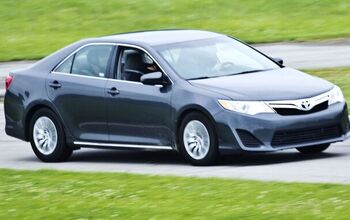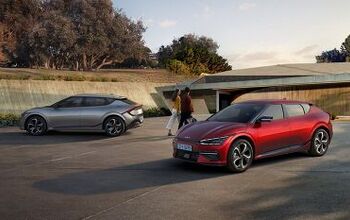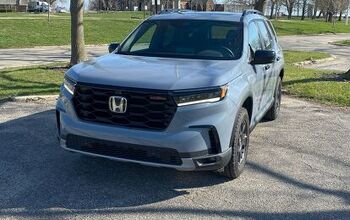Review: Toyota Sienna LE 2.7

Your humble author’s affection for the Pentastar-powered Chrysler minivans is relatively well-known within these electronic pages. In the interest of examining the so-called “alternatives”, however, I’ve been attempting to rent non-Chrysler minivans during my travels. A 36-hour unscheduled trip to San Francisco gave me a chance to do just that, deliberately walking past the six Corvette droptops in the Hertz #1 Gold Choice spaces and picking up a Toyota Sienna. The things I do for you, dear readers! My appointment was a couple of hours inland, in Lodi, CA; the thought that I was pedaling a minivan away from the ocean when I could be driving a topless ‘Vette along it had me sobbing lightly behind my Prodesigns.
I was eventually able to screw my courage to the sticking-place, as it were, and get on with business. What follows is a 388-mile review of the Toyota Sienna LE, but there’s one little catch: if you want one just like my test vehicle, you’re out of luck.
For 2013, Toyota has discontinued availability of the 2.7-liter paint-shaker four-cylinder in the Sienna. As we’ll soon see, it won’t be missed by most potential buyers. All Siennas are now powered by the appears-in-just-about-everything Toyota 3.5-liter V-6. The equivalent 2013-model V-6 Sienna to the one I drove would cost you a whopping $30.980 plus the usual reprehensible Toyota-dealer stripe/tape/paint protection/frottage charges. That’s a full eight thousand bucks more than the Caravans I normally rent would cost before incentives. It also represents a considerable price increase over last year. The 2012-model-year four-banger Sienna I rented would only cost you $26,990, assuming you could find a time machine or a dealer with some overstock, and that about splits the difference between a Caravan SE and the current Sienna LE.
This generation Sienna acquired what John Updike would call “minor fame” as the chosen ride of a swaggering MILF, but the gap in desirability between the fully-loaded SE and this poverty-spec LE is apparent from two hundred feet away and becomes more so as you draw closer to the thing. Opening the door reveals an unpleasant sea of elephant-testicle polysomethinglene in a color best described as “dirty ivory”. The odd texture molded into the door panels can’t hide a series of waves and ripples seemingly baked into the plastic during manufacture. I was initially willing to attribute the warping to 31,600 miles in the California sun, but even where the tinted windows protected the plastic, there were visible finish imperfections. If Toyota was trying to channel the spirit of the original K-car-based minivans, they’ve done it; I remember similar defects all over the place in those ancient Voyagers. Of course, the current Caravan is well beyond that standard, and comparing it back to back with the Sienna the much cheaper Dodge comes off as the upscale contender.
While the Chrysler minivan’s dashboard has always been intended to mimic that of a traditional sedan as closely as possible, the Sienna goes the other way, splaying an array of oddly oversized controls over an asymmetrical plastic wave between driver and passenger. The climate controls are frankly ridiculous, particularly the fan control which uses two buttons and multiple LEDs to unsatisfactorily accomplish what’s done with a single knob in better cars. Blank panels are everywhere. This van doesn’t appear to have any features except cruise control. The steering wheel has no secondary buttons whatsoever. Perhaps the kindest thing one could say about the Sienna’s controls is that they would all be easy to operate using gloves. They’re also perhaps deliberately optimized for Toyota’s aging customer base. The Avalon’s like that, too; every button and knob in the thing appears to be designed for people suffering a combination of Alzheimer’s and loss of motor control. The 12-volt outlet is too close to the floor — this is one detail that the Sienna has in common with the Caravan. One bright spot: the stereo is actually pretty decent. My two current test tracks (“English House” by Fleet Foxes and “My Activator” by 100s) were easily capable of annoying pedestrians in the vicinity and, in the case of the latter song, earned me a knowing nod from a stunning chica working the Jack-in-the-Box drive-through.
While the Sienna has about the same mouse-fur bucket seat for the driver you get in the cheaper Chrysler minivans, the story is completely different for rear-seat passengers. Chrysler offers their outstanding Stow N Go seats as standard pretty much everywhere in the lineup. They work just like you’d expect, folding quickly into the floor without fuss and turning the Caravan into a very capable work van in the space of five minutes. The Sienna, on the other hand, has two very conventional and very large bench seats in back. They’re well-bolstered and, for this writer at least, are usefully more comfortable than the Stow N Go. If you never expect to do anything with your minivan besides drag people around in it, the Sienna scores a big win here. If you need flexibility, the Chryslers are untouchable in that regard.
On the move, it’s quickly apparent that the Sienna and Caravan are from two entirely different schools of vehicular-dynamic thought. Simply put, the Sienna sucks as a driving proposition in every way that matters. The engine is completely gutless and feels thoroughly overmatched in this application, lugging against too much gear before giving up, changing down with an audible clunk, and hellishly moaning at its retro six-grand redline. The brakes feel completely worthless in hard usage, although that can probably be at least partially attributed to the miseries of rental life. Fast lane changes in the Sienna are positively nautical; my Town Car is noticeably better at controlling its body motion in the same situation. In the evening cut-and-thrust around the SFO airport, I gave up early and resigned myself to being dive-bombed for lane position again and again. My knee repeatedly turned off the low-mounted cruise control, exacerbating the situation somewhat and no doubt further alienating my fellow motorists.
I had hoped that the Sienna’s futuristic shape might pay off in wind noise reduction, but it was louder inside than the Caravans by some margin. There’s an extra A-pillar window as a consequence of that sleek silhouette, but as far as I can tell it’s completely worthless in actual use and I’d rather have a lower sticker price with a GM-style modesty panel shoved in the gap.
After a pair of 115-mile jaunts in the Sienna, I was more or less sick of the thing and I looked forward to returning it as soon as possible. From the wavy interior plastic to the gutless engine to the total lack of surprise-and-delight features, my tester van felt like an extremely cynical effort to cash in on the brand loyalty earned by other, far superior Toyota products. It’s worth noting that Toyota has never really had a killer app for the minivan market, unless your idea of the perfect family wagon is a supercharged suppository shape with the engine somewhere under the driver’s ass. It’s hard to imagine any reason for purchasing this current offering other than naked fear that the competition won’t be as reliable. I would suggest that these fears should be partially mitigated by the fact that one could buy three Caravans for every two Siennas one might hope to own.
It is true, however, that I have seen many an utterly miserable-looking old Sienna continuing to plow away with a quarter-million miles on the clock. Perhaps this Sienna is meant to anticipate a similar future by already looking crappy at 31,600 miles. Perhaps it would never get any worse. It’s hard to tell. If it still looks like this years from now, that wouldn’t be so bad. I also wonder if Toyota’s decision to drop the four-cylinder was such a great idea. Yes, it’s very slow, and yes, it’s very coarse, but I trust it more than I trust any Toyota V-6. If I had to drive a Sienna for the next decade and cover all the expenses myself, I might be tempted to choose the four, even though it barely clocked 22mpg in my unenthusiastic stewardship. There’s no possible reason to own a Sienna other than the explicit expectation of Land-Cruiser-in-Africa-style long-term durability, and the 2.7L would be an asset on that particular balance sheet.
I’m a car guy, you know? I like cars and I can usually find a reason to get enthusiastic about almost anything I drive. The Sienna LE 2.7L was a rare exception. I disliked it from the moment I backed it out of its stall at Hertz and realized it didn’t have parking sensors, and our relationship never got better. I’m not saying you should buy a Caravan over this thing — some people have been too badly burned by Chrysler minivans to ever give them a second chance. I am, however, saying you should choose something else. Even the most die-hard Toyota fan deserves better than this.

More by Jack Baruth
Latest Car Reviews
Read moreLatest Product Reviews
Read moreRecent Comments
- Lorenzo The unspoken killer is that batteries can't be repaired after a fender-bender and the cars are totaled by insurance companies. Very quickly, insurance premiums will be bigger than the the monthly payment, killing all sales. People will be snapping up all the clunkers Tim Healey can find.
- Lorenzo Massachusetts - with the start/finish line at the tip of Cape Cod.
- RHD Welcome to TTAH/K, also known as TTAUC (The truth about used cars). There is a hell of a lot of interesting auto news that does not make it to this website.
- Jkross22 EV makers are hosed. How much bigger is the EV market right now than it already is? Tesla is holding all the cards... existing customer base, no dealers to contend with, largest EV fleet and the only one with a reliable (although more crowded) charging network when you're on the road. They're also the most agile with pricing. I have no idea what BMW, Audi, H/K and Merc are thinking and their sales reflect that. Tesla isn't for me, but I see the appeal. They are the EV for people who really just want a Tesla, which is most EV customers. Rivian and Polestar and Lucid are all in trouble. They'll likely have to be acquired to survive. They probably know it too.
- Lorenzo The Renaissance Center was spearheaded by Henry Ford II to revitalize the Detroit waterfront. The round towers were a huge mistake, with inefficient floorplans. The space is largely unusable, and rental agents were having trouble renting it out.GM didn't know that, or do research, when they bought it. They just wanted to steal thunder from Ford by making it their new headquarters. Since they now own it, GM will need to tear down the "silver silos" as un-rentable, and take a financial bath.Somewhere, the ghost of Alfred P. Sloan is weeping.


































Comments
Join the conversation
I've got a belated question about "any Toyota V-6", too. It's related to reader "slavuta"'s question, which Jack never answered. So, what was wrong with those v6's and does that include the 2.4L v6?
I am resurrecting the dead here, and I cannot explain why I am reading up on a Sienna. Especially why I am reading up on the unloved 2.7L. I must say though... very well written article, Jack. I just drove the Sienna 2.7 without actually driving it. Yet, the experience was much worse for you by a wide margin.